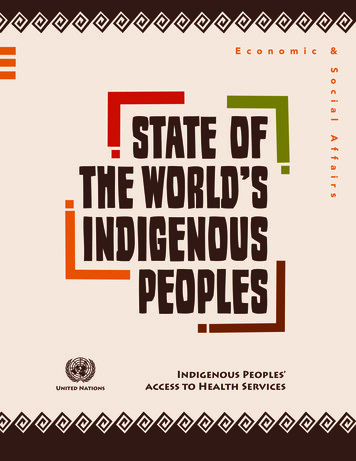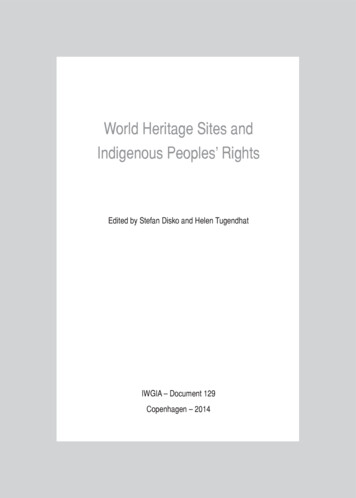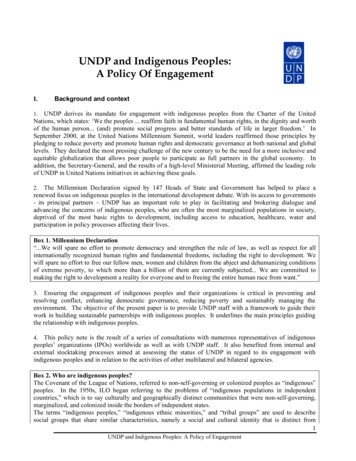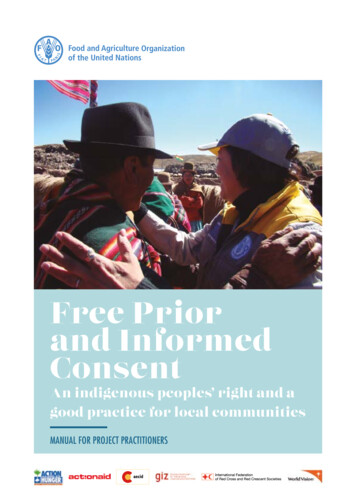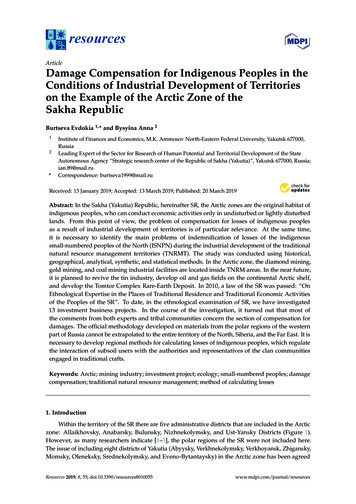
Transcription
resourcesArticleDamage Compensation for Indigenous Peoples in theConditions of Industrial Development of Territorieson the Example of the Arctic Zone of theSakha RepublicBurtseva Evdokia 1, * and Bysyina Anna 212*Institute of Finances and Economics, M.K. Ammosov North-Eastern Federal University, Yakutsk 677000,RussiaLeading Expert of the Sector for Research of Human Potential and Territorial Development of the StateAutonomous Agency “Strategic research center of the Republic of Sakha (Yakutia)”, Yakutsk 677000, Russia;ian.89@mail.ruCorrespondence: burtseva1999@mail.ruReceived: 13 January 2019; Accepted: 13 March 2019; Published: 20 March 2019 Abstract: In the Sakha (Yakutia) Republic, hereinafter SR, the Arctic zones are the original habitat ofindigenous peoples, who can conduct economic activities only in undisturbed or lightly disturbedlands. From this point of view, the problem of compensation for losses of indigenous peoplesas a result of industrial development of territories is of particular relevance. At the same time,it is necessary to identify the main problems of indemnification of losses of the indigenoussmall-numbered peoples of the North (ISNPN) during the industrial development of the traditionalnatural resource management territories (TNRMT). The study was conducted using historical,geographical, analytical, synthetic, and statistical methods. In the Arctic zone, the diamond mining,gold mining, and coal mining industrial facilities are located inside TNRM areas. In the near future,it is planned to revive the tin industry, develop oil and gas fields on the continental Arctic shelf,and develop the Tomtor Complex Rare-Earth Deposit. In 2010, a law of the SR was passed: “OnEthnological Expertise in the Places of Traditional Residence and Traditional Economic Activitiesof the Peoples of the SR”. To date, in the ethnological examination of SR, we have investigated13 investment business projects. In the course of the investigation, it turned out that most ofthe comments from both experts and tribal communities concern the section of compensation fordamages. The official methodology developed on materials from the polar regions of the westernpart of Russia cannot be extrapolated to the entire territory of the North, Siberia, and the Far East. It isnecessary to develop regional methods for calculating losses of indigenous peoples, which regulatethe interaction of subsoil users with the authorities and representatives of the clan communitiesengaged in traditional crafts.Keywords: Arctic; mining industry; investment project; ecology; small-numbered peoples; damagecompensation; traditional natural resource management; method of calculating losses1. IntroductionWithin the territory of the SR there are five administrative districts that are included in the Arcticzone: Allaikhovsky, Anabarsky, Bulunsky, Nizhnekolymsky, and Ust-Yansky Districts (Figure 1).However, as many researchers indicate [1–3], the polar regions of the SR were not included here.The issue of including eight districts of Yakutia (Abyysky, Verkhnekolymsky, Verkhoyansk, Zhigansky,Momsky, Oleneksky, Srednekolymsky, and Eveno-Bytantaysky) in the Arctic zone has been agreedResources 2019, 8, 55; esources
Resources 2019, 8, 552 of 14Resources 2019, 8, x FOR PEER REVIEW2 of 14withGovernmentof the withRussianFederation, butnotRussianyet approved[4]. Thus,districtsareArcticthezonehas been agreedthe Governmentof theFederation,but ,[4]. Thus, 13 districts are assigned to the arctic and northern zone of the Republic, with population ofofwhicharethe indigenousof the(Figure1). Theof thisstudytomorethan20,00070,000people,of which peoples20,000 arethe Northindigenouspeoplesofpurposethe North(Figure1). sofindigenoussmall-numberedpeoplesofthepurpose of this study is to identify the main problems of compensation for losses of indigenousNorth(ISNPN) rce managementterritoriessmall-numberedpeoplesof the North(ISNPN)ofduringindustrialdevelopmentof ingthem.resource management territories (TNRMT) and recommendations for solving them.Figure 1. Mining in the Arctic zone of Yakutia (2017).Figure 1. Mining in the Arctic zone of Yakutia (2017).The procedure of ethnological examination begins with a competitive tender for itsThe procedureof ethnologicalexaminationbegins witha competitivetenderfor itsimplementation.The maindocuments submittedfor ethnologicalexpertiseare (a) a draftof rethnologicalexpertiseare(a)adraftofeconomic and other activities; (b) an assessment of the impact of the projected activity on the originalproposedand otheractivities;(b)peoplesan assessmentthe impactof the Department—FERD).projected activity onhabitatandeconomicsocio-culturalsituationof small(Foreign uralsituationofsmallpeoples(ForeignRelationsThe composition of the expert committee and the expert opinion are approved byEconomicthe onof thethe expertopinion aretheSR. The author of this(BurtsevaE.I.)expertwas a committeemember ofandthe expertcommissionfor approved10 objectsby ethnologicalthe Governmentof the SR.andTheforauthorof thisarticlea memberof theexpertofexamination,1 objectservedas (Burtsevathe Head E.I.)and wasExecutiveOfficerof relatedcommission for 10 objects of ethnological examination, and for 1 object served as the Head and
Resources 2019, 8, 553 of 14FERD [5] Customer—Prognoz PJSC, 100% of which is owned by the Canadian company Silver BearResources Plc.At present, the many researchers have raised the question of sharing the benefits from thedevelopment of mineral deposits on TNRMT between industrialists, authorities, and indigenoussmall-numbered peoples. Tulaeva S. and Tysiachniouk M. [6] considered various models of distributionof benefits: paternalism; corporate social responsibility and partnership. At the same time, theyemphasize that, despite the introduction of more formalized methods for calculating the losses ofISNPN, an amount of the compensation does not allow restructuring a traditional economy on anew basis. Tysiachniouk M. et al. [7] considered the issues of agreements on benefit sharing in anoil sector of the Russian Arctic and Subarctic on the example of the Irkutsk oil region. The articleemphasizes that despite a significant diversity of the existing agreements, none of them ensurethe sustainable development of local communities, which is associated with the incompatibility ofpost-Soviet heritage, principles of corporate social responsibility, and local institutional structures.Tysiachniouk M. and Petrov A. [8] argue that the indigenous communities do not equally benefit fromoil and gas production, and no single model of benefit sharing policy provides the sustainable localdevelopment. They propose to improve the knowledge base on the benefit sharing in the Arctic energysector and call on the Arctic Economic Council to conduct a generalizing study with participationof many interested parties to develop the guiding principles for companies on the benefit sharingagreements in the Arctic.In Yakutia during the Soviet times the interaction of the mining companies and the populationliving in the territory affected by the industrial facilities was based on paternalism. In 1993, theGovernment of RS(Ya) commissioned the Joint Stock Company ALROSA to annually transfer 2%of proceeds from sales of precious stones to improve the environmental situation of the DiamondProvince. Compensatory measures included seven programs: construction, ecology, social protection,health, education, sports, and interregional relations [9].One of tragic pages associated with the development of the diamond deposits was relocation of theEvenki village of Tuoy-Khaya, which was flooded during the construction of the Vilyuy hydroelectricpower station designed to provide electricity for the diamond industry. In 1993, 40 million rubles atprices of that time were transferred from a fund of the Supreme Soviet of the Russian Federation forrevival of the traditional activities of the Evenks and Evens of the Mirny and Suntarsky districts andmaterial assistance to poor groups of the population. However, these funds were not used for theirintended purpose and did not reach addressees (individuals) [10].At present, compensation payments to the indigenous small-numbered peoples for the loss of thenatural resources (reindeer pastures, hunting areas, fish resources, and reserves of wild-growing plants)began to be put into practice only after the issue of the Law “On Ethnological Expertise . . . ” [11].There are no agreements on the sharing of benefits from the industrial development of TNRMT inthe Republic, but in conclusions of the experts of the ethnological expertise, as well as the scientificstudies, this question is being considered and it is recommended to approve the tripartite agreementon cooperation between the industrial companies, state authorities of the RS(Ya), and authorizedrepresentatives of the ISNPN [12–14]. Thus, the current practice of the compensation payments to theindigenous small-numbered peoples of Yakutia from the loss of the natural resources as the result ofthe industrial development of TNRMT can be considered as one of the mechanisms for benefit sharing.In recent years, quite a lot of scientific publications have appeared in the Republic on ethnologicalexpertise and assessment of the impact of industrial facilities on the life of the indigenous peoples:on the development of the Russian Arctic, legal issues of ethnological expertise [15–17]; losscalculation method for ISNPN [14,18]; assessment of the impact of industrial facilities on huntingresources [19–21]; history of Arctic exploration [22]; ethnological examination of projects [23–25];the issues of compensation of damage to indigenous peoples from industrial development ofterritories [26]; environmental problems of the Arctic and northern territories of Yakutia [27]; socialsecurity system for ISNPN [28], etc.
Resources 2019, 8, 554 of 142. Materials and MethodsThe following materials were used to complete this study: Research works with participation of the author in the framework of comprehensive researchaimed at the development of productive forces and the social sphere for 2016–2020:--- “Comprehensive Assessment of the Impact of Climate Change and Industrial Developmentof the Arctic on the Livelihoods of the Indigenous Population of Yakutia’s NizhnyayaKolyma District”. Line 1 “Improving the Quality of Life of Yakutia’s Population” (2016);“Assessment of the State and Analysis of the Main Trends in the Natural and Socio-EconomicStatus of Human Potential in the Arctic Economic Zone of the SR”. Line 1. Assessment ofthe Current State of Socio-Economic Complexes (2017);“Comprehensive Studies of the Impact of Changes in the Original Habitat of IndigenousPeoples and the Socio-Cultural Situation on the Development of the Ethnic Group Duringthe Industrial Development of Traditional Environmental Management Areas” (2017);Government Decree of the SR on the Integrated Program “Socio-Economic Development of theArctic and Northern Districts for 2014–2017 and for the Period up to 2020”;Government Report about the State and Protection of the Environment of the Sakha (Yakutia)Republic in 2014 [29];FERD materials on 13 investment projects;Opinions of the expert commission of ethnological expertise on 13 investment projects;Expeditionary materials in Ust-Yansky (2018) and Anabarsky District (2018) of Yakutia.The study of the industrial development of the Arctic of its impact on TNRMT and the life ofthe indigenous peoples was carried out using the following methods: historical and geographical(historical and territorial aspect of industrial development), analytical and synthetic (theoreticalanalysis and synthesis of literary sources), statistical (using statistical data on environmental pollutionfor 2001–2014), expeditionary and survey (socio-economic studies of the population (Evens) living inthe territory of “Vertikalny” silver deposit development at Mangazeysky ore field in SR’s KobyayskyDistrict). For the assessment of pollution in the Arctic areas of natural complexes of the Republic weused methods recommended by Burtseva E.I. [30], i.e., universal quantitative indicator (UQI)—thepercentage of the attribute in the estimated system of parameters. This is the factor intensity index(FII), which is the deviation from the average state of the object in relative terms. The essence of themethodical approach is to bring indicators with a different unit of measure into a single quantitativelycomparable system using this index, which is determined by the formula:UQIi ai,Mwhere: ai —absolute value of the i-th indicator; M—absolute average value of a set of indicators.In order to compensate for the losses of the indigenous minorities of the North, Siberia, and the FarEast, in 2009 the method of calculating the amount of losses caused to the associations of these peopleswas published for the first time [31]. However, the application of the document in specific projectsof impact assessment on the ethnological environment (FERD) caused many controversial issues,and some of its provisions were not acceptable for calculating the damage [14]. Potravny et al. [24]on the basis of studies conducted in areas of compact residence of indigenous peoples in the Arcticzone of the Republic (for example, the activities of the group of companies “Almazy Anabara”), offermechanisms for public–private partnerships between government, business, and local communitiesfor the socio-economic development of Arctic communities.
Resources 2019, 8, 555 of 143. Results3.1. Compensation of Damage with Subsoil UseThe withdrawal of land plots for the needs of subsoil use is necessarily accompanied by therequirement of payment of compensation and compensation for the losses caused by the subsoil user.Experience of Foreign Countries. Practically from the very dawn of the mining industry, starting fromthe 15–18th centuries, a number of western countries’ subsoil users (France, Germany, England, etc.)tended to remunerate the owner of the land plot for damages [32]. Currently, foreign countries have aflexible economic mechanism of compensation measures. For example, in the states of Colorado andNevada (USA), mining firms begin their activities only after transferring the cost of reclamation and thecost of restoring natural resources to a special account. After mining operations, the money transferredis returned to the company for the restoration of disturbed land [33,34]. In Canada, agreements areconcluded on compensation for the impact of industrial facilities between mining companies andindigenous peoples. Agreements for indigenous peoples include specific benefits and proceduralmeasures aimed at protecting their interests and providing compensation in case of damage: paymentsor funds for community development, development of community infrastructure (public buildings,roads), monitoring and environmental protection, employment, recultivation, restoration, and transferof land after the development, etc. [35].Indemnification in Russia. Compensations for damage as a result of industrial activity in theUSSR first began in 1962, when the state began to pay state farms and collective farms monetarycompensation for the removal (loss) of agricultural land, and thus the damage to natural resources,was officially recognized. In the early 1990s in Russia, the environmental policy pursued by thestate was fundamentally changed, when state environmental review bodies were ordered not to takeinto consideration any pre-planned, pre-project, and project documentation without information onenvironmental impact assessment (EIA). Unlike most foreign countries, where the EIA procedureand environmental impact assessment have been legislatively consolidated (USA—1969, Japan—1973,Canada—1974, Sweden—1975, etc.), in our country the EIA procedure received legal status only in2001 with the first law of the Russian Federation “On the Protection of the Environment” (1991).3.2. Mining Industry DevelopmentThe mining industry in the Arctic and the northern territories began to develop from thedevelopment of a coal deposit in the Verkhnekolymsky region (1936), and during the Second WorldWar, underground mining began with development of Ese-Khaya Tin Deposit in the VerkhoyanskDistrict (1941). In 1951, the “Deputatsky” Mine was opened in the Ust-Yansky District. The year 1961saw the start of diamond deposits development: the Aikhal Open-Pit mine (1961) in the Mirny District(Figure 2). In 1963, there was gold mining in the lower reaches of the Yany River: “Kular” Mine inUst-Yansky District. All of these deposits, except for Ese-Khaya, were developed using the open-pitmethod. Market relations, which began in 1991, led to the emergence of crises in almost all sectors ofthe mining industry of Yakutia (except for the diamond and oil and gas) and many enterprises wereliquidated (Table 1).Today in the Arctic zone of TNRMT there are objects of diamond, gold, and coal mining industries(Table 2).Diamond Mining Industry. Starting in 1997, the Aikhal Deposit (after completion of the open pitmining), has been converted to an underground mine. Today the mine has reached its design capacityof 500 thousand tons of ore. The development of placer diamond deposits in the Republic began in the1990s. In 1994, the Nizhne-Lenskoye Diamond Mining Enterprise was established, which in 2013 sold100% of the shares to Almazy Anabara OJSC. The company was established in 1998 to develop alluvialdiamond deposits in the Anabarsky, Bulunsky, Oleneksky, and Zhigansky Districts. Since 2014, newmountain areas have been developed: “Ebelyakh” and “Gusiny” in Anabarsky, and the developmentof the “Verkhnee Molodo” section in the Olenek District began.
Resources2019, 8,55 8, x FOR PEER REVIEWResources2019,Resources2019, 8,x FOR PEER REVIEW6 of 146 of 156 of 146 of 15Resources 2019, 8, x FOR PEER REVIEWFigure 2. “Aikhal” Open-Pit Mine, open-pit diamond mining.Figure 2. “Aikhal” Open-Pit Mine, open-pit diamond mining.2. “Aikhal”Mine, open-pitdiamondmining.TableFigure1. Liquidated(closed)Open-Pitmining enterprisesin the Arcticregions(1951–1994).Figure 2. “Aikhal” Open-Pit Mine, open-pit diamond mining.Table 1. Liquidated (closed) mining enterprises in the Arctic regions (1951–1994).Start enterprisesLiquidationTable 1. Liquidated (closed) miningin the Arctic regions odrativeStart enterprisesLiquidationTable 1. Liquidated(closed) miningin the Arcticregions(1951–1994).AdministYear Start YearLiquidation Mining YearYearIndustryEnterprise Despoit“Ese-Khaya”19411968Закрытый 41 1941 19681968Закрытый (подземный) акрытыйTin Mining“Deputatsky” Deposit (MPC)1952 1952 19971997Ust-YanskyTin Mining“Ese-Khaya”Открытый kyTin Mining19521997Открытый (карьерный)Ust-Yansky(MPC)Tin putatskolovo”JSC19901999““ ” ”“Sakhaolovo”LLCUst-Yanskyy1952 2000 19901999“”(карьерный)(MPC)Gold Mining“Kular” Deposit19631994“ “”“Deputatskolovo” 002009“Sakhaolovo”LLC20002009“ “” ”Ust-YanskyyUst-YanskDiamondAnabarsky,Gold Mining“Kular” Deposit19631994GoldMiningMining“Kular”Deposit OJSC 1963 1994 19942013“ “”“ ” nskGold Mining“Kular” � Deposit19611997“”Mirninsky“Aikhal” skoe”Anabarsky,“Aikhal” Deposit19611997Mining19942013“ “” ”AnabarskyOJSCZhigansky,OlenekskyTable2. Active mining enterprises in the arctic regions Activemining enterprisesinthe arctic regions (1998–2015).Industry yIndustryEnterpriseStartDistrictMethod (underground)yAnabarsky,arctic regions (1998–2015).Diamond Mining Table 2. Active mining enterprises in theClosed“Aikhal”1998OpenBulunsky,Table 2. DepositActive mining enterprisesin the arctic regions(1998–2015). Mirninsky“Almazy Anabara” OJSC (underground)1998Mining (open-pit ky,Method1998ClosedAnabarsky,OJSC Deposit(open-pit nd)ClosedAllaikhovsky,“Aikhal”Deposit Holding1998MirninskyOlenekskyGold Mining“Arctic-Capital”2015“ 1998Gold Mining2015“ lmazyAnabara”OpenBulunsky,HoldingCoal MiningZyryansky Coal Mine1936“ -pit mine)Zhigansky,Tin Mining Zyryansky“Tirekhtyakh”2015“ ��Allaikhovsky,Coal MiningCoal Mine RIC1936“ ”VerkhnekolymskyGold MiningHolding“Arctic-Capital”Tin MiningGold Mining “Tirekhtyakh” nabarsky,Allaikhovsky,Ust-YanskyBulunsky,Gold Mining Industry. Today, one of the successful mining companies for the extraction of gold isGold MiningHolding,Industry. whichToday,consistsone of thesuccessfulminingcompaniesfor theextractiongold“Arctic-Capital”of tenindependentcompanies(LLC).Eachof them ofcarriesis “Arctic-Capital”Holding,geologicalwhich consistsof ten transportationindependent companies(LLC). Eachofofthemoutits own type of activity:exploration,of goods, nofand processing equipment, etc. In total, the holding employs 881 people—all local personnel, whichmining and processing equipment, etc. In total, the holding employs 881 people—all local personnel,
Resources 2019, 8, 557 of 14contributes to the creation of new jobs for young people, among which there is a high degree ofunemployment [36].Coal Mining Industry. The beginning of the development of a coal deposit in the VerkhnekolymskyDistrict is considered to be 1936, when 8.5 thousand tons of coal were mined at the Zyryansk CoalMine. At that time, the district was part of the Dalstroy Area of USSR’s NKVD (People’s Commissariatfor Internal Affairs). Currently, coal mining is carried out in the Northeastern District on the basis ofthe development of the Zyryansk Coal Basin (Verkhnekolymsky District) in the Nadezhdinsky sectionwith more favorable mining and technical conditions for development [37].Tin Mining Industry. Due to the economic crisis in the country, the fall in tin prices on the worldmining market was closed in 1997. However, today tin mining has every chance of a rebirth: the RICgroup is implementing a large project of the Tirechtyakhsky Tin Deposit with a capacity of 3000 tonsfor 20 years. In 2015, “Yanolovo” won a license for 65 million rubles for the right to use the subsoil ofthe Tirekhtyakh Stream. For the development of the deposit, the RIC Group attracts a Chinese investor,currently negotiations are continuing with a Chinese partner [38].Perspective ProjectsToday in North Yakutia, within the framework of complex geological and geophysical studies,a study has begun on the junction area of the Leno-Tunguska oil and gas province and the Laptevskayapotential oil and gas area with the prospect of further development. The area of complex geologicaland geophysical works for the search for oil and gas deposits and their subsequent exploitation islocated in the territory of the Bulunsky and Anabarsky Districts of the SR. The following will fallunder the influence of geological and geophysical works in the territory of the Anabarsky Ulus: fourtribal communities in the Terpey Thumus Resource Reserve (the Terpyay Tribal Community) and twomunicipal unitary enterprises. In the Bulunsky District, Taymylyrsky MUE and KFH Skrybykin I.G.Peasant Farm Enterprise will be affected by these works.One of the promising investment projects is the development of the Tomtor Complex Rare-EarthDeposit (niobium, yttrium, scandium, lanthanum, etc.) in the Tomtor-Taas Area of the Olenek District.The content of rare-earth metals in its ores reaches 12%, the explored reserves amount to 150 milliontons, while the Tomtor ores contain rare metals, in particular, large concentrations (about 5%) ofniobium [39]. Tomtor rare earths are radioactive due to the content of uranium and thorium. Accordingto the results of the integrated environmental monitoring of the Ministry of Natural Resources ofYakutia (2014) in certain areas of the Buranny licensed site, where active exploration and mining of oreis planned, the background radiation reaches 40 µR/hour (safe values are 5–25 µR/hour) [40].In August 2014, a meeting was held between representatives of the leadership of the SR andlocal residents in the Saskylakh Village of the Anabarsky National District, where they discussed theissue of the changing borders of “Terpey-Tumus” [40] SPNA. To provide fuel and energy resourcesfor the development of the Tomtor Deposit, industrialists need an autonomous power supply. At thesame time, it is planned to use Pronchishchevskaya Oil and Gas Deposit for the construction of itsown power generation facilities, but the problem is that it is located on the Terpey-Tumus ResourceReserve. From time immemorial, the indigenous minority peoples of the Anabara—the Evens,the Evenks, the Dolgans—have lived on the resource reserve and they are engaged in traditionaltypes of environmental management. Here lie the lands of several tribal communities, rich in fish, fowl,and wild plants. The meeting ended in favor of the local population: having united the efforts of themunicipal authorities, deputies of all levels, the Anabarians managed to convince the government thatthey were right. As a result, it was decided that “RT—Global Resources” LLC will conduct geologicalexploration at SPNA under the control of the Ministry of Nature Protection, the entire productionprocess will be accompanied by continuous monitoring.
Resources 2019, 8, 558 of 143.3. Environmental PollutionClosure of many unprofitable enterprises in the gold, tin, and coal mining industries in thepost-Soviet period has led to the reduction of many sources of environmental pollution, which has ledto a reduction in emissions of pollutants into the air and pollutants into water bodies. For example, inthe Arctic zone, low levels of pollution are identified for pollution of surface waters (Table 3) [27].Table 3. Discharges of Polluted Wastewater to Surface Water in Arctic and Northern Areas.Name of UlusDischarges (Average for2001–2010), Million 1.601.811.96DischargesRanking ScalePollution Degree0.000.000.000.000.020.040.040.100.150.17 0.2Low0.240.270.300.21–0.4LoweredHowever, despite the reduction of pollution sources, the Arctic coast remains one of theecologically unfavorable regions of Russia. To date, the most acute problem in environmental terms ispollution of surface waters. The condition in the rivers of the Lensky basin is assessed by pollutionclass 4 (dirty). According to the complex of the main pollutants, the waters of the river basin flowinginto the Arctic Ocean are classified as follows: Yana—“dirty”; Anabar at s. Saskylah—“very polluted”;Indigirka—“dirty”; Kolyma and Olenyok—“polluted” [27]. A special role in environmental pollutionis played by the effects of underground nuclear explosions (UNE) conducted in North Yakutia. A totalof four UNEs were conducted, of which two—“Kristall” and “Kraton-3”—were officially recognizedas “accidental” with releases of radionuclides to the surface. At present, the sources of environmentalpollution are still the effects of the industrial development of the Soviet Arctic: disturbed lands of themining industry, facilities of the liquidated (closed) enterprises of the tin and gold mining industry,abandoned weather stations, airfield sites of a military unit of the Russian Ministry of Defense, etc.The sources of environmental pollution are still the effects of the industrial development of theArctic during the Soviet era:1.2.Disturbed lands of mining industry.Objects of the liquidated enterprises of tin and gold mining industry (tailing dump): 3.4.Deputatsky Processing Plant (Ust-Yanskiy Ulus);Kularskaya Gold Processing Plant (Ust-Yanskiy Ulus).The Arctic coast: abandoned weather stations (Bulunsky and Nizhnekolymsky uluses).The Arctic coast (Kotelny and Bolshoy Lyakhovsky islands): airfield sites of a military unit of theMinistry of Defense of the Russian FederationA special contribution to the deterioration of the ecological situation was made by theunderground nuclear explosions “Gorizont-4”, “Kristall”, “Kraton-3”, the las
At present, compensation payments to the indigenous small-numbered peoples for the loss of the natural resources (reindeer pastures, hunting areas, fish resources, and reserves of wild-growing plants) . for 2001-2014), expeditionary and survey (socio-economic studies of the population (Evens) living in
